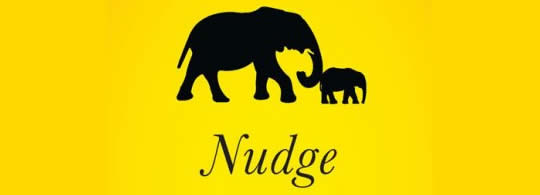Nudge by Thaler and Sunstein

Book Review: Nudge: Improving Decisions About Health, Wealth, and Happiness by Richard H. Thaler and Cass R. Sunstein
Nudge is all about choice architecture, a discipline which structures choices in a way that produces the most beneficial outcome. I don’t have to tell Neuromarketing readers that humans often behave in conflict with the traditional economist’s view of rational decision-making. Thaler and Sunstein not only provide plenty of evidence of irrationality, but they show how to avoid some of the problems it causes.
The classic example of poor choice architecture is the 401K retirement plan in the U.S. (see 401K Choice Architecture Gone Awry?). When pension plans were an automatic benefit of being employed at most firms, there was little or no decision-making involved; once you were employed for a minimum period of time, you began building your pension. When you retired, if the company had not gone bust, you started collecting. 401Ks, in contrast, require a set of choices that can bewilder a non-financial person. You must first elect to participate, then choose an amount to save, some of which may be matched by company payments, and then choose the actual investment allocation. When confused by a complicated decision, many people simply don’t decide at all. Even in 401K plans that have an excellent company match amount, all too many employees take an unwitting pay cut by failing to sign up. The person who suffers, of course, is the individual who doesn’t enroll in the 401k plan. But society suffers too if a large contingent of people arrive at retirement age with no resources of their own and expect the government to support them.
The “nudge” needed to reverse this situation is to make the 401K plan opt-out rather than opt-in. Motivated individuals can still adjust their contribution levels and pick the investment vehicles they find attractive, but even the flummoxed novice who does nothing is at least socking some money away for retirement and taking advantage of company matching payments. (The Awry article points out that because many firms set the default percent very low, some individuals save less than they would had they decided themselves. This is a fixable by bumping the default percent up to a somewhat higher level, a move which would benefit all default participants.)
Thaler and Sunstein call this kind of choice architecture “libertarian paternalism.” This seeming oxymoron implies that a society can be paternalistic and guide people to make choices that benefit them while providing full freedom of choice for those who don’t want the guidance or who want to opt out of whatever is being offered.
Ballot-Box Nudges
The authors note that poor choice architecture governs much of the voting process in the United States. While numerous studies show that the name listed first on the ballot gets a disproportionate number of votes, the order of candidates isn’t randomized to produce a fair result. Rather, the order is most often determined by the incumbent party who can structure the listings to favor their candidates.
Organ Donations
Another area where choice architecture fails society in the U.S. is organ donation. Despite a need for organs so desperate that many patients die annually for lack of a transplant, most states in the U.S. require “explicit consent.” A person willing to donate their organs after death must proactively take some action to express that consent. Thaler and Sunstein contrast that with other approaches, like “presumed consent,” in which one not wishing to donate their organs post-mortem must opt out. The most aggressive approach described by the authors is “routine removal” in which the state legally owns the organs after death and can remove them without permission. This sounds bizarre, but in limited implementations it has had astounding results. Georgia changed its law to require cornea removal from deceased residents when necessary, and the number of cornea transplants jumped from 25 to more than a thousand in the space of a few years.
Planning Nudge
Yale seniors were unwitting participants in an experiment described by Thaler and Sunstein. The students all received a lecture on the dangers of tetanus and the importance of getting a tetanus shot. They were told when and where shots would be available, and most indicated they would get one. In fact, a mere 3% of the students showed up to be injected. A second group, in addition to hearing the presentation, got an additional nudge. They were given a map showing the health center’s location, asked to determine the route they would walk to get there, and told to check their calendars to plan a time. They weren’t given an appointment, and, as seniors, would have had no problem finding the location without the map, but this additional nudging resulted in 28% showing up, a nearly tenfold increase!
While the focus of Nudge is mostly on public policy, business readers can find plenty of examples of “nudging” examples and useful takeaways in the book. As marketers and managers, we are always trying to get people to make the best choice or to take some action, but often the way we present that choice or action is structured to yield poor results. By thinking about these issues in terms of choice architecture, we can ethically nudge our customers and employees to better decisions.
Amazon Link: Nudge: Improving Decisions About Health, Wealth, and Happiness
Kindle Link: Nudge: Improving Decisions About Health, Wealth, and Happiness
